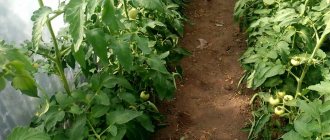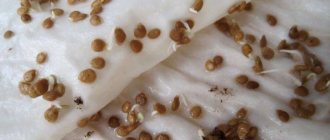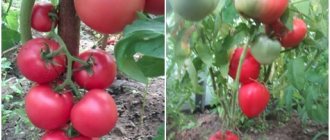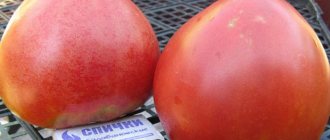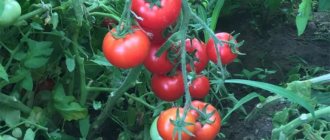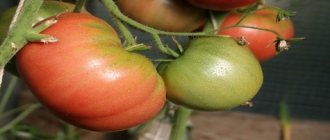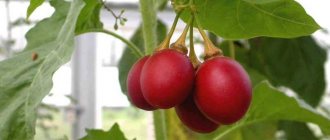Description of the tomato variety Pink Snow
The Pink Snow tomato is an indeterminate plant, which means unlimited stem growth. A tall tomato requires gartering and formation into one trunk. The leaves of the variety are large, dark green in color, and the foliage is medium. The inflorescence is complex, the stalk has an articulation.
Photos, descriptions and reviews of the Pink Snow tomato show oval-shaped fruits with a smooth surface. The color of unripe tomatoes is light green, ripe - pink. Number of nests – 2-3. The weight of one tomato is about 50 g. The ripening period is average, 3 months pass from planting to fruit maturity.
Advantages and disadvantages of the variety
The variety is classified as a valuable crop; it is distinguished by high fruit set under various growing conditions.
A small bush produces up to 10 kg of tomatoes per season
pros
- unpretentiousness in cultivation;
- resistance to pests and diseases;
- tolerance to temperature changes, both downward and upward;
- drought resistance;
- high productivity;
- good taste;
- versatility.
Minuses
- regular removal of stepsons;
- forming a bush with 2-3 stems;
- tying up the plant.
Attention! Tomato has few negative qualities, and even those are attributed to the peculiarities of growing indeterminate crops.
Pros and cons of the Pink Snow tomato variety
The Pink Snow variety is a cocktail tomato. Their peculiarity is their sweet taste, oblong shape and long shelf life on the hand.
Other advantages of the variety:
- possibility of growing in open ground;
- early ripening;
- unpretentiousness in cultivation;
- productivity.
The disadvantages or characteristics of the plant include the need to form a stem and the constant removal of stepsons. Pink Snow tomatoes are more suitable for fresh consumption than for harvesting.
Rules of care
You need to water the tomato bushes in the evening with warm water. For the effectiveness of growing the variety, it is recommended to use fertilizers in liquid form. They are introduced from the 10th day after planting in open ground.
The formation of a bush is carried out in one stem, so the removal of stepsons is required. They grow very quickly, and it is necessary not to miss their formation in order to remove them in time.
The bushes of the plant are long, which requires tying them up. Especially in places where there is a strong load on the stem.
Optimal growing conditions
The Pink Snow variety is suitable for growing in open ground and under film covers. It is resistant to heat and drought, as well as other adverse weather conditions.
Advice! Tomatoes are grown in high sunny areas with the possibility of ventilation, but without drafts and gusts of cold wind.
Highly fertile soil should have a neutral or slightly alkaline reaction. Acidic soils are limed in advance. The structure of the soil for growing tomatoes should be loose and light. Clay soils are improved by adding humus and compost. Dense soil is loosened with sand or rotted sawdust.
The place for growing tomatoes should be free of weeds. To reduce the risk of crop disease, it is not planted in areas where other vegetables of the Solanaceae family grew in the previous season.
Features of plant agricultural technology. Reviews from summer residents
The right time for sowing seedlings is from late February to early April. The seeds are planted to a depth of 2 cm. The sprouts sprout in the phase of 1-2 leaves. In addition to watering, young tomatoes will need 2-3 feedings with complex compounds. A week before rooting, the bushes are hardened off in a permanent place in the ground.
Sprouts are planted in open beds in the garden at the age of 50 days, after the threat of frost has passed. Scheme - 70x40 cm or 3 plants per 1 square. m. Tomato seedlings are placed in a heated greenhouse in April, and under temporary shelters in May. For an early harvest, the originator advises growing bushes with one stem. Practicing summer residents often leave 2-3. Step-sonning is mandatory.
The variety has collected a lot of good reviews online. People show off photos of bountiful harvests and praise the taste of tomatoes. Zhanna Fokina from the Moscow region has been growing Pink Snow for about 10 years, and in recent years she has been collecting the seeds herself. The biggest achievement during this time was a tomato cluster weighing 3 kg (there were about a hundred fruits on it).
Varietal tomato deserves the attention of summer residents. After all, even from one bush, with proper care, you can get a bountiful harvest.
Growing
Tomatoes of the Pink Snow variety are grown through seedlings. Sowing begins 50 days before transplanting into open ground. The first inflorescence of a tall variety is formed above the 9-11th leaf. It is not recommended to overgrow seedlings, but replanting plants in open ground is acceptable even with several flowers.
Growing seedlings
To grow seedlings, the soil must be loose; for this, fine river sand or coconut substrate is added to the soil. Ash and dolomite flour are added in small quantities to the fertile mixture. Seeds are sown both in general planting containers and in separate ones, but in both cases with further picking.
Reusable planting containers are disinfected with a solution of fungicides. Before planting, the soil is well loosened, leveled and watered. The seeds are laid out and covered with a soil layer 1.5 cm high. The crops are covered and placed in a warm place. Before the emergence of seedlings, the shelter is periodically opened for ventilation, the soil is sprayed with water as it dries.
When the first seedling loops appear, the planting containers are completely opened and transferred under additional illumination lamps, the temperature is reduced for several days to +18ºC, which helps strengthen the root system. To prevent seedlings from stretching out and dying during cultivation, they need 14 hours of lighting per day.
During the period when 2-3 true leaves appear, the seedlings dive into larger containers. After picking, the seedlings are placed spaciously so that the leaves of the plants do not touch each other.
A week before planting, the plants are taken out onto balconies or outside, increasing the time spent in conditions of increased light and oxygen, so the seedlings gradually adapt to open ground conditions.
Landing rules
Plants are transplanted into the ground after constant positive air temperatures have been established. Tomato bushes may die from any drop in temperature. A cloudy day is chosen for transplantation. Tomatoes are planted according to the following scheme: 3 pcs. per 1 sq. m.
Advice! Fertilizers are applied during general preparation of the ridge or separately in each hole.
The hole for planting is made according to the size of the seedling. Before planting, the plants are watered and removed from the planting container along with the earthen lump. The prepared hole is watered abundantly until moisture stops being absorbed. Plants are transferred to the soil by transshipment, leaving the cotyledon leaves on the surface. Then they are covered with earth and pressed lightly. After planting, the plants are not watered for 10 days.
Watering and fertilizing
Water Pink Snow tomatoes in the evening with warm water. Watering should be uniform, without drying out or waterlogging the soil. Water is poured under the bush without affecting the plant. It is best to use a drip irrigation system for growing tomatoes.
Advice! Fertilizers in liquid form are well suited for feeding tomatoes, for example, infusions of chicken manure, grass or ash.
The first time fertilizing is applied 10 days after transplanting the seedlings into open ground. The following feedings, if necessary, are carried out at intervals of 2 weeks.
Pinching and tying
The Pink Snow tomato is formed into one stem, which implies the complete removal of all stepsons - side shoots that grow not from the stem, but from the leaf axil, and are located at an angle of 45º.
Stepchildren grow quickly, so when growing a Pink Snow tomato, it is important to remove them on time. Excess shoots take up a lot of moisture and nutrients. It is best to remove stepsons in the morning and in sunny weather, so that the broken area has time to heal during the day. When removing a shoot, it is necessary to leave a part of it, the so-called stump, about 0.5 cm in size to prevent re-growth.
Tall tomato Pink Snow needs to be tied up. To ensure that the stems in the open ground do not break from the wind, receive enough sun and are well ventilated, they are tied to stakes or a trellis. The plants are tied up using synthetic twine or wide ribbons. To avoid damaging the stem, the node must be free.
Formation
The Pink Snow tomato has unlimited growth; in order to direct the plant’s forces to ripen the fruit, the top is pinched. Depending on the climate and place of cultivation, pinching is done at different heights of the stem at the end of summer. For open ground tomatoes, the stem is cut above the leaf, leaving 3 fruiting clusters; 4-5 clusters are left in the greenhouse.
During the formation of the stem, the lower leaves are gradually removed up to the first fruit cluster. This promotes good ventilation and the prevention of many crop diseases. But unlike removing stepchildren, leaves are plucked off no more than once per week. Leaves carry nutrients and moisture along the stem, so their sudden removal has an adverse effect on the development of the plant.
Protection from diseases and pests
Preventive spraying against pests and diseases is carried out immediately after strengthening the seedlings after transplanting in open ground. Treatments against diseases are carried out using fungicides at intervals of 10-14 days and are completed some time before harvest.
To prevent the appearance of pests, the soil is dug deep and treated with insecticides, and the plants are sprayed leaf by leaf with the same preparations.
Landing
It is recommended to sow seeds approximately two months before the plants are supposed to be planted in open ground or a greenhouse. They need to be planted to a depth of 2 centimeters. Then the pots with sowing are covered with film. The first shoots appear within a week. After they appear, it is recommended to remove the film.
The process of growing seedlings
The growth of Pink Snow tomato seedlings will be more effective if the pots have loose soil. To do this, add a little river sand to the soil. Ash is added for fertility. After at least three leaves appear, picking is carried out. To grow seedlings, you need a room with good lighting and a temperature of at least +18 degrees. To ensure good illumination, phyto lamps are used.
Approximately 6-7 days before planting in open ground, the plants are hardened off. To do this, take containers with seedlings out onto the balcony or veranda.
Planting in open ground
Tomatoes should be planted in the ground after the outside temperature is consistently above zero and the threat of frost has been eliminated. No more than 3 bushes are planted on an area of 1 sq.m. It is better to plant in pre-prepared holes according to the size of the seedling. It is not recommended to water the crop bushes for ten days.
Pest and disease control
The pink snow tomato is resistant to pests or diseases. But with high humidity in the greenhouse, apical rot, gray rot, and late blight develop on the leaves and fruits of tomato. Spraying with Bordeaux mixture will help protect the crop from fungus.
Late blight is a dangerous disease that damages the leaves and fruits of tomatoes.
The Colorado potato beetle is a major pest of nightshades.
The risk of Colorado potato beetles appearing in a greenhouse is minimal, but in garden beds it is high.
As soon as the striped beetle appears next to the tomato bush, it is treated with modern chemicals. They cannot be used after the ovaries have formed.
Review of new tomato varieties 2013 – My Tomatoes
Tomato varieties “Cherry” and “Cocktail”:
IRISHKA.
Ultra-early, high-yielding and late blight-resistant variety. The plant is 40cm high, semi-spreading. The fruits are oval-shaped, even and smooth, moderately dense, do not crack, weighing 25-30g, bright red, without a green spot on the stalk, excellent taste. For fresh consumption and whole-fruit canning.
BUTTON.
An early ripening, high-yielding and decorative variety, perfect for growing in pots. The plant is 50cm high, spreading. The fruits are oval-plum-shaped, bright red, very sweet and aromatic, excellent taste, weighing 20g.
